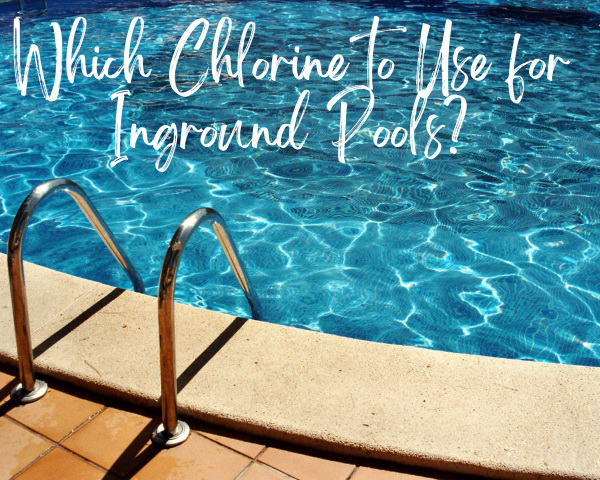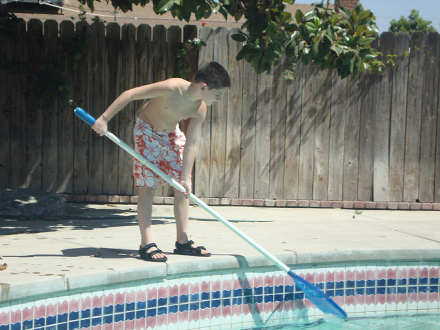There’s nothing more relaxing than lounging by the pool on a scorching summer day. But, as any other pool owner will tell you, the water maintenance is anything but carefree.
When it comes to choosing which chlorine to use for an inground pool, the sheer number of options is enough to give you a headache.
You start off wondering if you should use liquid or granular chlorine. But which product is most compatible with inground pools? Which is more affordable? And is a Chlorine Generator worth considering? The good news is this guide has all the answers you’re looking for.
The most popular types of chlorine used for inground pools are Cal-Hypo (calcium hypochlorite), Liquid chlorine (sodium hypochlorite) and Dichlor (dichloro-s-triazinetrione). Most pool owners opt for Cal-Hypo or Dichlor, as it comes in easy-to-use tablets or granular form, and is the least expensive option.
Follow along for an in-depth look at everything you need to know to choose the right chlorine for your inground pool.

Types of Chlorine for an Inground Pool
All chlorine products for inground pools can be divided into three categories. The product you choose will be determined by:
- Your own personal preference
- Your pool’s construction materials e.g. fiberglass, concrete, gunite, vinyl liner, tiles etc.
- Saltwater or regular chlorine pool
Chlorinated Isocyanurates AKA Stabilized Chlorine
Though there are other Chlorinated Isocyanurates on the market, Dichlor and Trichlor are by far the most widely used. Unlike other types of chlorine, they are stabilized with added Cyanic acid.
Pure chlorine quickly becomes ineffective when exposed to the sun. But since Trichlor and Dichlor are mixed with cyanic acids, they remain stable regardless of exposure to the Sun’s UV rays.
Though their names sound similar, there’s a significant difference between using Dichlor as opposed to Trichlor.
A word of caution, if trichlor or dichlor come in contact with a vinyl pool liner, they can weaken it. Be careful not to let this happen if you have a pool like this.
Dichlor
With a neutral pH and no Calcium content, Dichlor can chlorinate your pool without affecting its acidity or Calcium (Ca) concentration. It comes in granules that can either be added directly to the pool or dissolved in a bucket of water and poured along the inside lining.
Dichlor is one of the safest and most stable forms of pool chlorine. As long as the powder isn’t mixed with other pool chemicals (or other chlorine types). It can be stored in any dry, ventilated area.
Trichlor
With over 90% available Chlorine (Cl), compared to Dichor’s 60%, Trichlor tablets are the most concentrated chlorine product on the market. The downside is that you’ll need to invest in a chlorine feeder, to apply it. Chlorine feeders are sometimes called Chlorinators.
Trichlor is highly reactive. Even contact with dry contaminants like dirt or leaves can degrade it, and mixing it with other pool chemicals may even cause an explosion.
Related Reading: Should You Use Dichlor or Trichlor for Your Pool?
Hypochlorite Chlorines
Hypochlorites include some of the most time-tested products out there, though only two are still widely used today – liquid bleach (aka liquid chlorine or sodium hypochlorite) and calcium hypochlorite (cal-hypo).
Liquid Chlorine
Liquid pool bleach, or Sodium Hypochlorite, has a pH of almost 13, higher than any other type of chlorine. It is also not stabilized. That means if you choose to use bleach, you’ll need to supplement it with cyanuric acid, and a pH-decreasing solution.
Another issue with liquid chlorine is the way it increases TDS levels. When Total Dissolved Solids reach 2,000ppm, your pool filter can no longer work effectively.
With that said, it’s often the professionals’ choice of chlorine products.
The main reason liquid bleach is popular is its low price and that it doesn’t increase stabilizer levels (cyanuric acid). High stabilizer levels can be a major problem in pools.
It’s also easy to apply. Simply pour it in.
Another downside is that it is bulky to store and the shelf life is short. Which means regular trips to the pool store.
Can You Use Household Bleach?
Regular household bleach solution works just like the liquid chlorine you buy in pool stores. But its drawback is the low available chlorine content of about 6-7% (compared to the 13% in pool bleach).
The household variety also has a relatively short shelf life of six months, so you’ll need to restock on a regular basis.
If you do opt to use household bleach, like Clorox, make sure it doesn’t contain scents, colors, or any other additive.
Related Reading: Liquid Chlorine Vs Tablets – What’s Better for Your Pool?
Cal-Hypo
Cal-Hypo, which stands for Calcium Hypochlorite, is the king of hypochlorites. It comes in granular form and is the cheapest solid-state pool chloride available. You can sprinkle the granules directly into your pool, or dissolve them in a bucket of water first.
This type of chlorine should be avoided for saltwater pools as it increases calcium levels.
Although no other product is as popular, Cal Hypo comes with a long list of complications:
- Unstable
For daytime application, you will need to treat your pool with cyanuric acid first. If you’ve already been using Trichlor or Dichlor, you should have a stabilizer in the water so this is no big deal. Adding it to the water after sunset will also reduce the stability issue. - High pH
Cal Hypo has a pH of around 12. As such, you may need to adjust the acidity after applying it. - High Calcium (Ca) Levels
As the name suggests, this is a Calcium-based product. So for every ppm of chlorine the tablets produce, they also raise the Calcium content by 0.7ppm. When Ca levels reach 300-400ppm, pool water gets murky, cloudy, and may no longer be safe. - Hazardous
When it comes to safety, Cal Hypo is decidedly not the winner. It is extremely reactive, so any minor contaminant can cause smoke, fire, and explosions. As some pool owners find out the hard way, mixing Cal Hypo with Trichlor and water is a recipe for a bomb.
Related Reading: Which Chlorine to Use for Fiberglass Pools?
Chlorine Generators
A chlorine generator applies the concept of hydrolysis to pool water. In other words, it slowly generates chlorine from salt water.
Yes, that means chlorine generators only work in salt water pools. But before you opt-out, you should know that a “saltwater” pool doesn’t actually mean the water is salty.
For context, seawater measures around 35,000ppm of salt. Meanwhile, saltwater pools contain less than 3,000ppm.
Related Reading: 8 Tips To Maintain A Saltwater Chlorine Generator
Is a Salt Water Pool Worth It?
Saltwater pools also offer a number of benefits that other options lack:
- Time-saving – no trips to buy chlorine and no need to manually add it to the water
- No lingering chlorine odor
- Perfectly clear water
- The water remains soft (low ppm of additives), which means pool filters last longer
- Nice water feel – some people love the way a salt pool feels on the skin
The overhead cost of a generator is quite high. Instead of constantly buying chlorine, you simply buy salt. You’ll likely only need to top up the salt once or twice a year.
Related Reading: Beginners Guide to Saltwater Pool Maintenance
How Reduce Chlorine Costs for Inground Pools
At the end of the day, most people just need something that gets the job done. If you’re looking to get the most bang for your buck, these tips will help:
Supplement
The main purpose of chlorine is sanitation. So by supplementing your water maintenance routine with other sanitizers, you can significantly reduce the use of chlorine. Anything that kills bacteria will help, but the most popular supplemental sanitizers for inground pools are Bromine tablets and Ionizers.
- Ionizers are devices that add copper and silver ions to the water content. Both silver and copper have antibacterial properties that help keep your pool nice and clean.
Keep the Pool Clean
Keeping your pool spotless is probably the most effective thing you can do to reduce chlorine expenses. The more debris and organics in the water, the more chlorine you’ll need to neutralize these.
Here are some tips and tricks to maintaining a clean pool:
- Cover the pool with a pool cover when not in use.
- Regularly skim the pool with a net.
- Vacuum the pool regularly.
- Run the filter 8-12 hours per day in summer and 6 hours per day in winter.
- Maintain the correct pH – high pH reduces chlorine effectiveness.

Use a Feeder
If, like most pool owners, you choose one of the solid chlorine products, you can conserve tablets by using a feeder to apply them. Both offline and inline feeders allow you to measure and control how much chlorine is used, so you never overdo it.
Stabilize
If you prefer one of the hypochlorites, make sure to stabilize the water. Remember, direct sunlight will quickly degrade chlorine ions. Cyanuric acids are your best bet at making liquid chlorine and Cal Hypo last longer.
The stabilizer doesn’t degrade or evaporate. Once it’s in the water, it stays in the water. The only way it can be removed is by draining or splashing the water out of the pool and diluting the water (by topping up the pool with fresh water).
Related Reading:
Should You Use Stabilizer for Indoor Pools?
Should You Use Stabilized or Unstabilized Chlorine?
What is Swimming Pool Stabilizer & When To Add It
5 Chlorine Options to Keep Kiddie Pools Clean and Safe








